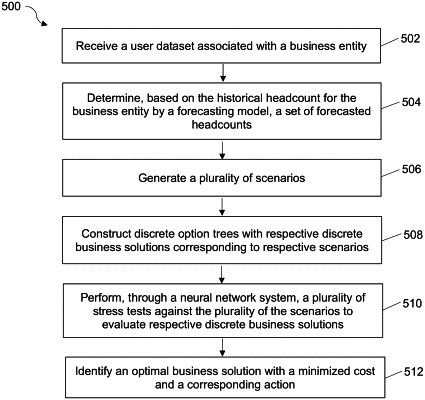| CPC G06Q 30/0645 (2013.01) [G06N 3/08 (2013.01); G06N 5/046 (2013.01); G06Q 10/10 (2013.01); G06Q 50/16 (2013.01)] | 18 Claims |

|
1. A computer-implemented method for optimizing future real estate solutions, comprising:
receiving, by a server computing device comprising a processor and a non-volatile memory storing computer-executable instructions, a user dataset associated with a business entity from a user computing device via a network, wherein the user dataset comprises a historical headcount associated with the business entity and a business objective dataset;
determining, based on the historical headcount associated with the business entity, a set of forecasted headcounts at different points of a future time span;
generating, based on the set of forecasted headcounts and the business objective dataset, a plurality of scenarios associated with the business entity;
constructing discrete option trees with respective discrete real estate solutions corresponding to respective scenarios;
performing, through a neural network system, a plurality of stress tests on the plurality of the scenarios against the respective forecasted headcounts and the discrete option trees to evaluate the respective discrete real estate solutions and determine respective costs and actions associated with the respective discrete real estate solutions, wherein the neural network system comprises a value network and a policy network that are alternatively trained until convergence, the value network being trained via a randomly weighted value function to predict the respective costs and actions associated with the respective discrete real estate solutions, and the policy network being trained via a randomly weighted policy function to predict an optimal real estate solution with a minimized cost based on an output of the value network, wherein the performing comprises:
generating, using the value network, a plurality of next actions for the business entity to take to minimize expected future costs based on the respective forecasted headcounts and the discrete option trees, and
selecting, using the policy network, the optimal real estate solution for the business entity to take based on the plurality of next actions generated by the value network; and
providing information for causing a visual representation identifying the optimal real estate solution for the business entity to be presented on a display of the user computing device.
|